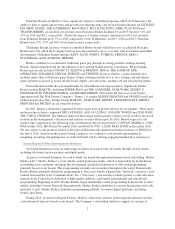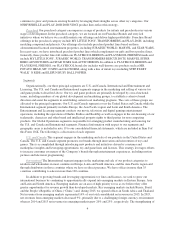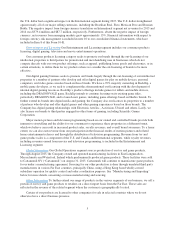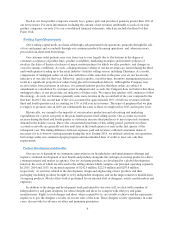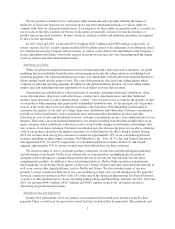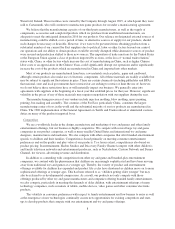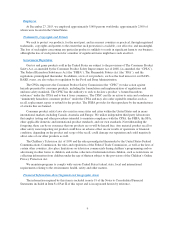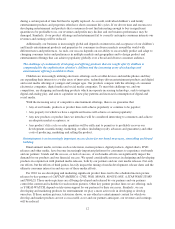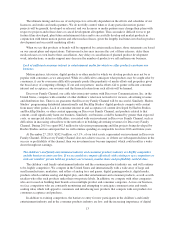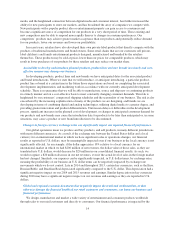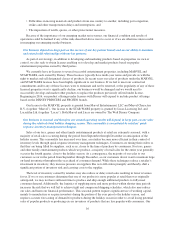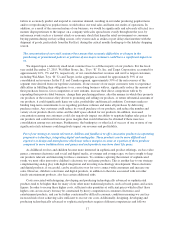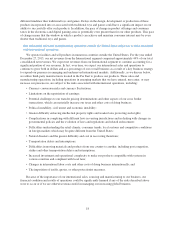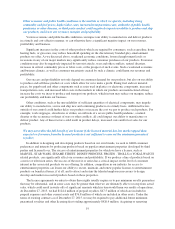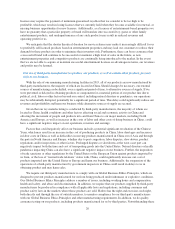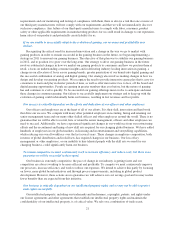Hasbro 2015 Annual Report Download - page 22
Download and view the complete annual report
Please find page 22 of the 2015 Hasbro annual report below. You can navigate through the pages in the report by either clicking on the pages listed below, or by using the keyword search tool below to find specific information within the annual report.similar matters. Forward-looking statements are inherently subject to risks and uncertainties. The Private
Securities Litigation Reform Act of 1995 provides a safe harbor for forward-looking statements. These
statements may be identified by the use of forward-looking words or phrases such as “anticipate,” “believe,”
“could,” “expect,” “intend,” “looking forward,” “may,” “planned,” “potential,” “should,” “will” and “would” or
any variations of words with similar meanings. We note that a variety of factors could cause our actual results
and experience to differ materially from the anticipated results or other expectations expressed or anticipated in
our forward-looking statements. The factors listed below are illustrative and other risks and uncertainties may
arise as are or may be detailed from time to time in our public announcements and our filings with the Securities
and Exchange Commission, such as on Forms 8-K, 10-Q and 10-K. We undertake no obligation to make any
revisions to the forward-looking statements contained in this Annual Report on Form 10-K or in our annual
report to shareholders to reflect events or circumstances occurring after the date of the filing of this report.
Unless otherwise specifically indicated, all dollar or share amounts herein are expressed in millions of dollars or
shares, except for per share amounts.
We are focusing our global efforts around our brand architecture, which includes a heightened emphasis
and reliance on our franchise and key partner brands, and development of those brands across the brand
blueprint.
We have made a strategic decision to focus on fewer, larger global brands as we build our business. We are
moving away from SKU making behaviors, which involve building a large number of products across many
brands, towards global brand building with an emphasis on developing our franchise and key partner brands,
which we view as having the largest global potential. As we concentrate our efforts on a more select group of
brands, our future success depends to a greater extent on our ability to successfully develop those brands across
our brand blueprint and to maintain and extend the reach and relevance of those brands to global consumers in a
wide array of markets. This strategy has required us to build and develop competencies in new areas, including
storytelling, digital content and consumer products. Developing and growing these competencies has required
significant effort, time and money. Our future success is dependent on our ability to continue building our brands
across the blueprint.
In 2015 revenues from our seven franchise brands, LITTLEST PET SHOP, MAGIC: THE GATHERING,
MONOPOLY, NERF, MY LITTLE PONY, PLAY-DOH and TRANSFORMERS, totaled 52% of our aggregate
net revenues. Our key partner brands, including DISNEY, MARVEL and LUCASFILM, also constitute a
significant portion of our overall business. In 2015, net revenues from our partner brands constituted 28% of our
aggregate net revenues. Together our franchise and partner brands are critical to our business. If we are unable to
successfully execute this strategy and to maintain and develop our franchise and key partner brands in the future,
such that our product offerings based on these brands are not sought after by consumers to the extent required to
maintain and grow those brands, our revenues and profits will decline and our business performance will be
harmed. In addition to continuing to grow and develop our existing franchise brands, successfully executing our
brand strategy may also require us to be able to successfully develop other brands, such as current challenger
brands, to franchise brand status. There is no guarantee that we will be able to do this.
Consumer interests change rapidly, making it difficult to design and develop products which will be popular
with children and families.
The interests of children and families evolve extremely quickly and can change dramatically from year to
year. To be successful we must correctly anticipate the types of entertainment content, products and play patterns
which will capture children’s and families’ interests and imagination and quickly develop and introduce
innovative products which can compete successfully for consumers’ limited time, attention and spending. This
challenge is more difficult with the ever increasing utilization of technology and digital media in entertainment
offerings, and the increasing breadth of entertainment available to consumers. Evolving consumer tastes and
shifting interests, coupled with an ever changing and expanding pipeline of entertainment and consumer
properties and products which compete for children’s and families’ interest and acceptance, create an
environment in which some products can fail to achieve consumer acceptance, and other products can be popular
11



